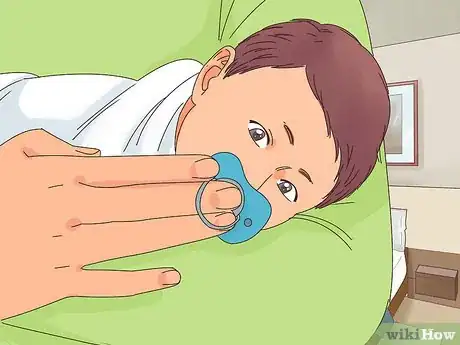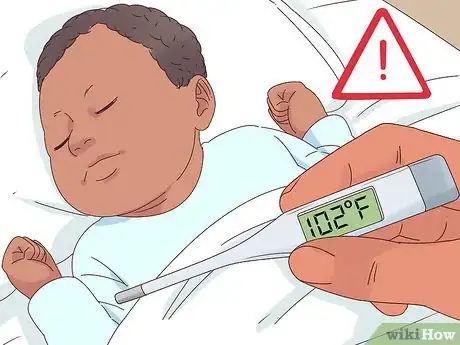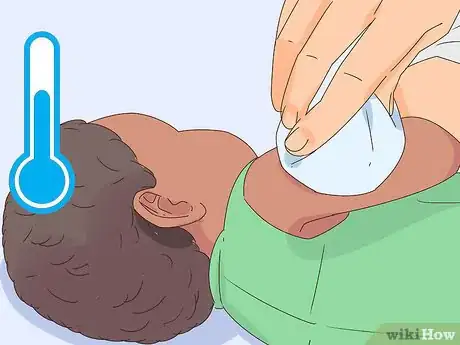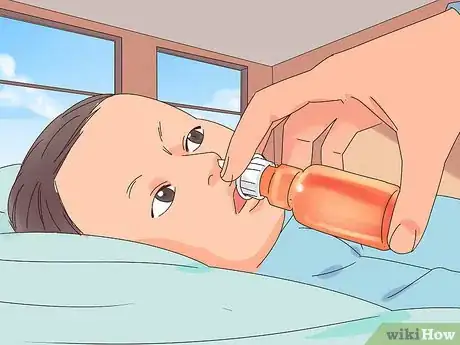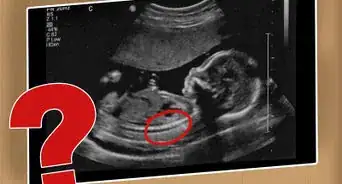This article was co-authored by Corey Fish, MD and by wikiHow staff writer, Megaera Lorenz, PhD. Dr. Corey Fish is a practicing Pediatrician and the Chief Medical Officer at Brave Care, a pediatric healthcare company based in Portland, Oregon. Dr. Fish has over 10 years of experience in pediatric care and is a member of the American Academy of Pediatrics. Dr. Fish received a BS in Biology from Pacific Lutheran University in 2005, an MD from the University of Washington School of Medicine in 2009, and completed his Pediatric Residency at the University of Texas Southwestern Medical School in 2012.
There are 13 references cited in this article, which can be found at the bottom of the page.
This article has been viewed 13,088 times.
Vaccinating your baby is vital for their health, but seeing them upset or in pain is always difficult. Fortunately, there are steps you can take to calm and comfort your baby. Immediately after their shots, you can soothe your baby by swaddling them and giving them something to suck on. If your baby develops a fever or pain after the shot, use cold compresses to relieve the pain and ask your doctor about giving them pain- and fever-reducing medications. Soothe your baby during the shot by distracting them and massaging the injection area.
Steps
Using the 5S Method
-
1Swaddle your baby immediately after the shot. As soon as the doctor is done giving your baby the shot, wrap your baby securely in a swaddling blanket.[1] Babies find swaddling comforting, since it reminds them of their time in the womb.
- You can swaddle your baby before the vaccination if you prefer, but make sure to leave their legs exposed for the shot!
- Swaddling may not work for older babies (i.e., over 4 months old). If your baby is too big to swaddle, just hug and hold them or wrap them loosely in a favorite blanket.
Did you know? Research shows that the 5S method (Swaddling, Side or Stomach positioning, Shushing, Swinging, and Sucking) is one of the most effective methods for soothing 2- to 4-month-old babies after shots.[2]
-
2Put your baby on their side or stomach. After swaddling your baby, position them on their side or stomach in your arms, on your lap, or on the exam table in the doctor’s office. This position is calming for babies because it gives them a sense of stability and security.[3]
- Do not put your baby on their stomach or side while they are sleeping or leave them unsupervised in this position. Side or stomach sleeping may increase the risk of sudden infant death syndrome (SIDS).[4]
Advertisement -
3Soothe the baby with shushing sounds. Get close to your baby and make gentle “shhh-shhh-shhh” sounds next to their ear. You can also try playing some quiet white noise or a recording of ocean waves crashing.[5]
- These sounds will remind your baby of the whooshing and rushing noises they heard in the womb.[6]
-
4Swing the baby in your arms or a baby swing. While you’re shushing your baby, rock them gently in your arms, a swing, or a baby carrier. This soothing movement will help calm and comfort them.[7]
- You may need to use big movements at first, then move on to gentler, slower swinging and swaying as your baby calms down.[8]
-
5Allow the baby to suck on a breast, bottle, or pacifier. Once your baby is calm enough, give them something to suck on. Breastfeeding is a great option, but if you’re unable to do that, try offering them a bottle or pacifier. The act of suckling will help send your baby into relaxation mode.[9]
- A pacifier dipped in sugar water can also soothe your baby during and after the shot.
Comforting a Baby with Pain or Fever
-
1Take your baby’s temperature if you suspect a fever. Sometimes, babies develop a fever after a shot. If you suspect a fever, place an electronic thermometer under your baby’s arm to check their temperature.[10] For a more accurate reading, consider using a rectal thermometer instead.[11]
- If your baby has a fever, they may be warm to the touch, fussy, more or less sleepy than usual, or not interested in eating.[13]
- 97.5 °F (36.4 °C) is a normal temperature for most babies. Any temperature above 100.4 °F (38.0 °C) is considered a fever.[14]
- Fevers from vaccines are typically mild and usually go away within 2-3 days.[15]
Tip: Call the doctor immediately if your baby has a temperature of 102 °F (39 °C) or higher, or a fever of 100.4 °F (38.0 °C) or higher if they are under 3 months old.[12]
-
2Give your baby plenty of fluids. If your baby has a fever, try to encourage them to drink. In most cases, using breast milk or formula should be fine. Call your pediatrician before offering your baby an electrolyte solution, such as Pedialyte.[16]
- Don’t give water to babies under 6 months old without consulting your pediatrician first.[17]
-
3Keep your baby cool to minimize the fever. While your baby has a fever, avoid wrapping them in blankets or dressing them in warm clothing. Keep the baby lightly dressed and place them in a cool (but not cold) area.[18]
- You can also cool and comfort your baby by giving them a sponge bath in lukewarm water. Just make sure the baby doesn’t get too cold, since shivering can drive the fever up.[19]
-
4Ask your doctor about using medicine to reduce the fever and pain. If your baby is feverish and seems to be in pain from the shot, talk to your pediatrician about giving them an over-the-counter medication, such as children’s acetaminophen (Tylenol) or ibuprofen (Motrin or Advil). These medicines can relieve fever and pain, and NSAIDs like ibuprofen can also reduce any swelling and inflammation at the site of the shot. Consult the doctor about what dosage is appropriate for your baby.[20]
- Never give aspirin to a baby or any child under the age of 18. In rare cases, aspirin may cause a life-threatening reaction in children called Reye’s syndrome.
-
5Use a cool, wet washcloth to reduce pain and swelling. If the site of the shot is warm, red, swollen, or seems to be causing your baby pain, you can use a cold compress to bring relief and reduce inflammation. Dip a clean washcloth in cool water, wring out the excess, and place the washcloth on the affected area.[21]
- If the redness and tenderness persist or get worse after 24 hours, call your pediatrician.
Preventing Discomfort During and After Shots
-
1Ask your pediatrician about using medication to prevent pain and fever. You may be able to prevent some of the discomfort associated with shots by giving your baby a dose of pain- and fever-reducing medication ahead of time. Ask your doctor if you can give your baby a little children’s ibuprofen or acetaminophen right before your appointment.[22]
- Acetaminophen may reduce the effectiveness of some vaccines. Always check with your pediatrician before giving your baby any medication.
-
2Discuss using an alternative to injections. Some vaccines can be delivered orally or as a nasal spray instead of as a shot. If you’re concerned about how your baby will react to the pain of an injection, ask your doctor about these alternatives.[23]
- In some cases, your pediatrician may be able to reduce the number of injections your baby needs by giving them a combination shot containing multiple vaccines.
-
3Stay calm while your baby is getting the shot. If you’re anxious and upset, your baby will pick up on it. Do your best to stay calm and relaxed. Smile at your baby and talk to them in a soothing, happy voice.[24]
- If you find yourself getting upset, take a few deep breaths. You may also find it helpful not to look at the needle while your baby is getting the shot—focus on your baby, instead.
-
4Hold your baby and distract them during the shot. During the shot, hold your baby in your arms or on your lap. Try distracting them by singing a song or showing them a toy. You could also try playing peekaboo or making funny faces.[25]
- Some doctor’s offices have toys or bubbles handy to keep babies happy and distracted during shots.
-
5Massage the injection site before and after the shot. Just before the injection, gently press or rub on the site where the shot will be delivered. After the injection, rub the area again for about 10 seconds. This will help reduce any pain and fever associated with the shot.[26]
Did you know? A recent study found that massaging the site of a shot can make the vaccine more effective![27]
References
- ↑ https://kidshealth.org/en/parents/baby-vaccinations.html
- ↑ http://pediatrics.aappublications.org/content/129/5/815.abstract?papetoc=
- ↑ https://www.arnoldpalmerhospital.com/blog/soothing-your-baby-after-shots-with-the-5-ss
- ↑ https://www.thebump.com/a/how-to-soothe-baby-after-a-vaccination-use-the-five-ss
- ↑ https://www.thebump.com/a/how-to-soothe-baby-after-a-vaccination-use-the-five-ss
- ↑ https://www.arnoldpalmerhospital.com/blog/soothing-your-baby-after-shots-with-the-5-ss
- ↑ https://www.thebump.com/a/how-to-soothe-baby-after-a-vaccination-use-the-five-ss
- ↑ https://www.arnoldpalmerhospital.com/blog/soothing-your-baby-after-shots-with-the-5-ss
- ↑ https://www.thebump.com/a/how-to-soothe-baby-after-a-vaccination-use-the-five-ss
- ↑ http://www.immunize.org/catg.d/p4015.pdf
- ↑ https://www.thebump.com/a/baby-fever
- ↑ https://www.mayoclinic.org/diseases-conditions/fever/symptoms-causes/syc-20352759
- ↑ https://www.thebump.com/a/baby-fever
- ↑ https://www.nhs.uk/conditions/pregnancy-and-baby/how-to-take-your-babys-temperature/
- ↑ https://www.seattlechildrens.org/conditions/a-z/immunization-reactions/
- ↑ https://www.thebump.com/a/baby-fever
- ↑ https://www.verywellfamily.com/water-for-babies-and-how-advice-changes-over-time-2634469
- ↑ http://www.immunize.org/catg.d/p4015.pdf
- ↑ https://www.thebump.com/a/baby-fever
- ↑ http://www.immunize.org/catg.d/p4015.pdf
- ↑ http://www.immunize.org/catg.d/p4015.pdf
- ↑ https://living.thebump.com/soothe-baby-after-shots-9317.html
- ↑ https://living.thebump.com/soothe-baby-after-shots-9317.html
- ↑ https://living.thebump.com/soothe-baby-after-shots-9317.html
- ↑ https://living.thebump.com/soothe-baby-after-shots-9317.html
- ↑ https://living.thebump.com/soothe-baby-after-shots-9317.html
- ↑ https://www.ncbi.nlm.nih.gov/pubmed/7567283




